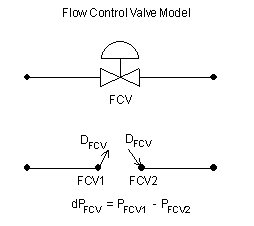Modeling and Troubleshooting Flow Control Valves
Flow control valves (FCVs) maintain the flow rate in a line to a fixed value and calculate the differential pressure across the control required to regulate the flow rate. When troubleshooting FCV installations, it is helpful to know how PIPE-FLO internally models them.
A schematic of how PIPE-FLO internally models FCVs is shown below:

The following points about FCVs should be noted:
- The direction of flow through the FCV is determined from the direction of the connecting pipelines.
- PIPE-FLO models a FCV by creating two nodes in the system where the valve is installed (refer to the figure). A flow demand value equal to the set flow rate is taken out of the first node (the inlet node) and an equal flow demand is set entering the second node (the outlet node).
- The program will calculate the valve inlet pressure based on the upstream conditions, and calculate the valve outlet pressure based on the downstream conditions.
- If the inlet pressure is greater than the outlet pressure, the control valve differential pressure is displayed (if selected in the Drawing Options).
- If the calculated inlet pressure is less than the outlet pressure, a warning is generated stating that the "Flow rate cannot be achieved", and a message is displayed in the Fly-by Viewer stating that the "Valve is operating like a pump with a total head" displayed in ( ). These results are invalid and indicate that the upstream pressure needs to be higher to achieve the desired flow rate. If a pump is installed upstream, the pump is undersized and is not generating enough head.
- If Cv data is entered for the control valve, a "Flow exceeds range of supplied curve" error can be generated if the set flow rate would result in the valve being less than 5% open or more than 100% open.
- For a control valve with Cv data, a "Choked Flow" error message will be generated if the set flow rate of the control valve is greater than the calculated Qmax of the valve. Choked flow can occur when the fluid pressure at the vena contracta of the valve drops significantly below the fluid vapor pressure and the valve's Liquid Pressure Recovery Factor (FL) is low enough that the fluid pressure does not rise back above the vapor pressure. The calculated results are invalid because the flow rate (and therefore the head loss and dP) of the system is based on the set flow rate of the control valve and not the maximum flow rate that is attainable with the valve.
-
流量阀模型和故障排查流量控制阀(FCV)保持管道中的流量达到一个固定值,并计算出调节流量所需控制的差压。在安装FCV进行故障排除时,有助于了解PIPE-FLO内部如何对FCV进行建模。PIPE-FLO内部模拟FCV的示意图如下所示:
应注意有关FCV的以下几点:- FCV中流量的方向是由连接管道的连接方向决定的。
- PIPE-FLO通过在系统中需要安装阀门的位置创建两个节点来模拟FCV(如图)。从第一个节点(入口节点)取出等于设定流量的流量需求值 ,并将它设置为进入第二节点(出口节点)的流量。
- 程序将根据上下游情况计算出阀入口和出口的压力。
- 如果入口压力大于出口压力,将显示控制阀差压(如果早在图中做了选择)。
- 如果计算出的入口压力小于出口压力,产生“流量无法实现”的警告,并且Fly-by Viewer中显示一条消息,在()中显示“阀门正在像没有水头的水泵一样运行”。这些结果是无效的并且表明上游压力需要更高以达到期望的流量。如果上游安装了泵,则泵的尺寸过小,并且没有产生足够的水头。
- 在为控制阀输入Cv数据时,如果设定的流量导致阀门的开度小于5%或超过100%,则可能会产生“流量超过供应曲线范围”错误。
- 对于具有Cv数据的控制阀,如果控制阀的设定流量大于计算出的阀门Qmax,则会产生“阻塞流量”错误信息。当阀腔内收缩处的流体压力明显低于液体蒸汽压力时,可能会发生阻塞流量,并且阀的液力恢复因子(FL)足够低,使得流体压力不会升高到高于蒸汽压力。计算结果无效,因为系统的流量(头部损失和dP)基于控制阀的设定流量,而不是阀门可达到的最大流速。






















 3万+
3万+











 被折叠的 条评论
为什么被折叠?
被折叠的 条评论
为什么被折叠?








